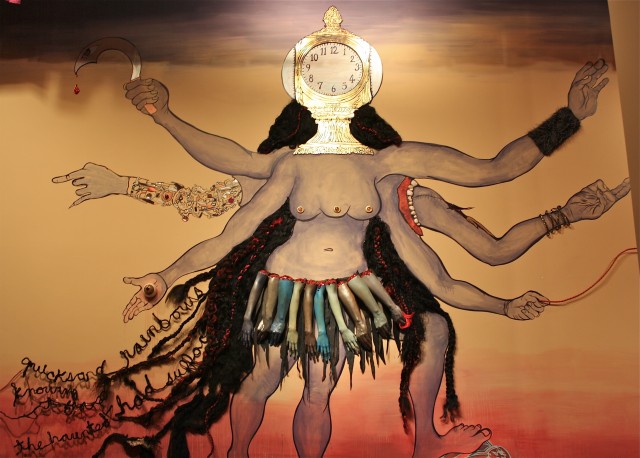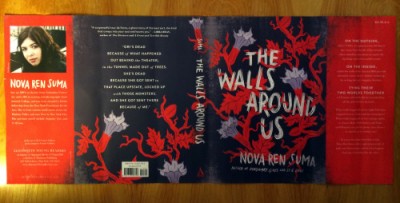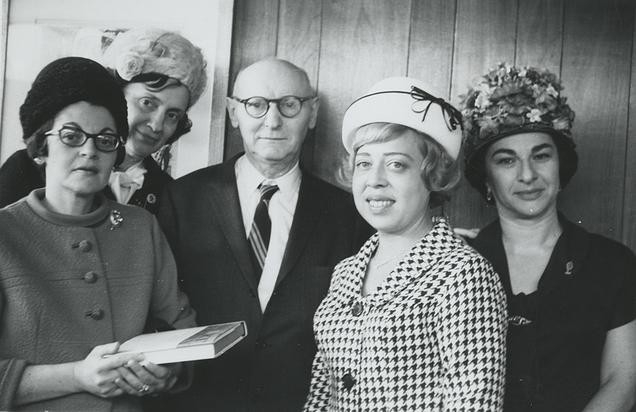Who: Neil Diamond
What: Neil Diamond Live in Concert
Where: Barclays Center, 620 Atlantic Ave., 800-745-3000
When: Thursday, March 26, $30-$175, 8:00
Why: It’s hard to believe, but on Thursday night, Rock and Roll Hall of Famer Neil Diamond will be playing his first public show ever in his home borough of Brooklyn, where he was born on January 24, 1941, highlighting songs from throughout his career as well as from his latest album, Melody Road (CMG, October 2014), which was produced by Don Was and Jacknife Lee. Get ready for a major lovefest, especially given the tour’s setlist, which includes “I’m a Believer,” “Love on the Rocks,” “Cherry, Cherry,” “I Am . . . I Said,” “Cracklin’ Rosie,” and “Sweet Caroline.” As Diamond himself recently proclaimed, “It’s going to be so good, so good, so good.”
twi-ny recommended events
THE EVENING

Asi (Brian Mendes), Beatrice (Cammisa Buerhaus), and Cosmo (Jim Fletcher) contemplate life in Richard Maxwell’s THE EVENING (photo by Paula Court)
The Kitchen
512 West 19th St. between Tenth & Eleventh Aves.
Tuesday – Saturday through March 28, $20-$25, 8:00
212-255-5793 ext11
thekitchen.org
www.nycplayers.org
In his latest play, simply titled The Evening, experimental writer-director Richard Maxwell, head of the New York City Players, takes apart and rebuilds the way experience is structured as theatrical presentation. When The Evening had its world premiere in January as the opening selection of the Walker Art Center’s “Out There” festival, it began with Maxwell (Isolde, Netural Hero) sitting down at a table and reading a story about the recent death of his father, who had passed away while Maxwell was well into writing and rehearsing his new work. But in its New York premiere, a coproduction of the Kitchen and Performance Space 122 at the former’s black-box theater in Chelsea, the show starts with Cammisa Buerhaus reading Maxwell’s personal tale, in a straightforward, somewhat impersonal and direct voice. When she is finished, she becomes Beatrice, a bartender in a drinking establishment that couldn’t be more plain. Her only customers this night are Cosmo (Jim Fletcher), a balding, middle-aged fight manager dressed in a blue-gray velour tracksuit, and Asi (Brian Mendes), a low-level mixed-martial-arts fighter with a heavily bruised face. The easygoing Cosmo just wants to hang out, drink beer and Jell-O shots, smoke pot, and eat pizza, explaining, “I like this place, I’m not going to lie. Can’t really think of any better place to be.” Asi is determined to get back in the cage and keep fighting despite his middling career. And Beatrice is tired of it all, ready to run away to Istanbul by herself. Cosmo, who flirts with Beatrice, thinks she should go, but Asi, who might or might not be her boyfriend, is insistent that she stay. Meanwhile, a band arrives, consisting of two men (guitarist James Moore, drummer David Zuckerman) and one woman (bassist Andie Springer), mirroring the barfly love triangle, and starts playing moody indie songs (written by Maxwell). When Beatrice makes a surprise, unexpected move, all three of them suddenly have to face who they are and what they want out of this mundane, virtually hopeless life.
The Evening takes place in a “lonely corner of the universe,” where archetypal characters speak in actorly voices on a stage that reveals itself as an artificial theatrical construct; set designer Sascha van Riel also keeps the lights on throughout the show, a constant reminder to the audience that what they are watching is not real. As things get a bit crazy between Cosmo, Asi, and Beatrice, the band keeps playing, looking at the action but not the slightest bit worried that it will affect them, even as danger lurks. There’s a shock when Beatrice pulls out a gun and puts it down heavily on the bar, the sharp, loud sound echoing throughout the theater, forcing a kind of reality back into the fold. (The only other purely real elements are the pizza Cosmo is eating and the SEC college football game that is playing on a flat-screen television.) Melding Pirandello’s Six Characters in Search of an Author and O’Neill’s The Iceman Cometh with Brecht and Beckett, Maxwell explores the differences between fact and fiction, reality and fantasy, form and function, real people and stage performers, then tears it all down and reconstructs it in a dazzling existential finale. “We live in this garbagey void,” Asi says to Beatrice, “of all the old tropes of standing still and forgotten dreams.” The first in a trilogy inspired by Dante’s Divine Comedy, The Evening packs a whole lot to think about in its brief sixty-five minutes, reinterpreting old tropes and investigating the human condition as it fades out into a memorable, elegiac landscape of hazy hopes and dreams.
ART OFF THE WALL — CHITRA GANESH: EYES OF TIME
Brooklyn Museum
Elizabeth A. Sackler Center for Feminist Art, Herstory Gallery, fourth floor
200 Eastern Parkway at Washington St.
Thursday, March 26, free with museum admission, 6:00-9:30
Exhibition continues through July 12
212-864-5400
www.brooklynmuseum.org
www.chitraganesh.com
eyes of time online slideshow
In her exceptional new site-specific installation, “Eyes of Time,” in the Brooklyn Museum’s Herstory Gallery, multimedia artist Chitra Ganesh investigates female divinity, multiplicity, and power, inspired by the goddess Kali, one of the women honored with a place setting in Judy Chicago’s seminal work “The Dinner Party,” the centerpiece of the museum’s Elizabeth A. Sackler Center for Feminist Art, home to the Herstory Gallery. Ganesh, a lifelong Brooklynite, supplements her wall sculpture with selections from the museum’s collection, comprising contemporary works by Kiki Smith, Shoichi Ida, and Barbara Jones-Hogu as well as a small seventeenth-century Indian bronze of a standing Kali and an ancient Egyptian bronze of a seated Sekhmet. “In mythic tales both Sekhmet and Kali are connected to blood, death, destruction, and protection, and to fierce animals such as lions and tigers,” Ganesh writes in a wall label. “These qualities contrast with characteristics typically idealized in women today and point to the formidable roles played by the ancient goddesses.” About Louise Bourgeois’s 1996 drypoint, “Eyes,” Ganesh adds, “The third eye, as seen on Kali, has often been associated with supernatural powers in Indian mythology and continues to appear in contemporary imagery. The act of gazing into numerous eyes might also recall the practice of darshan, a dialectical and spiritual way of looking that considers the object as both image and living being, providing an experience of seeing that informs South Asian culture.”
Those explanations also offer just the right way to approach “Eyes of Time,” a sprawling mural of three women that covers one wall of the gallery. At the left is a contemporary figure holding a jagged, starlike piece of the universe over one eye while the other eye looks directly at the viewer. In the middle is a figure based on Kali, the goddess of time, change, and destruction, who has six arms, three legs, three breasts, and a skirt of severed arms of different colors. Words emerge from her long hair, including “quicksand,” “rainbows,” and “knowing.” One hand has an eyeball in its palm, one holds a whip, while another wields a blood-dripping scythe with an eye on it. Instead of a head, on her neck is the Grand Central clock, without its hands. And on the right is a science-fiction woman made out of such machine parts as gears and speakers laid out in a kind of architectural rendering. All three women, representing the past, the present, and the future, have shiny jewels embedded into their being, while two rows of decorated flags hang above them. In some ways, it’s like the three figures have escaped from Ganesh’s comic book Tales of Amnesia, which is also on view, giving three-dimensional life to these superhero characters. “These narrative devices allude to the power of multiple forms of femininity that coexist within the same frame and, at times, within a single being, as well as to darker aspects of Kali,” Ganesh writes about her 2002 book. On March 26, the Brooklyn Museum’s next edition of “Art Off the Wall” will celebrate “Eyes of Time” with an evening of special activities, consisting of an artist and curator talk with Ganesh and Saisha Grayson, a zine library inspired by Tales of Amnesia, screenings of three of Ganesh’s short films (Rabbithole; What Remains; My dreams, my works must wait till after hell…), a movement workshop with Ajna Dance Company, and a Bhangra dance party with DJ Rekha.
NOVA REN SUMA: THE WALLS AROUND US BOOK LAUNCH WITH LIBBA BRAY
THE WALLS AROUND US (Algonquin Young Readers, March 24, $17.95)
McNally Jackson
52 Prince St. between Lafayette & Mulberry Sts.
Monday, March 23, free, 7:00
212-274-1160
mcnallyjackson.com
novaren.com
“We went wild that hot night. We howled, we raged, we screamed. We were girls — some of us fourteen and fifteen; some sixteen, seventeen — but when the locks came undone, the doors of our cells gaping open and no one to shove us back in, we made the noise of savage animals, of men.” So begins Nova Ren Suma’s third YA novel, the ghost story The Walls Around Us. Her follow-up to Imaginary Girls and 17 & Gone, Suma’s latest book is told from the point of view of a convicted killer and a ballerina (Suma herself danced from the age of six to sixteen) and includes quotes from Shirley Jackson’s The Haunting of Hill House, Alice Sebold’s The Lovely Bones, and Margaret Atwood’s The Handmaid’s Tale to help set the mood. Suma, who we once had the extreme pleasure of working with in the children’s books business, is a master of her craft, creating warm, believable characters, writing sharp, realistic dialogue, and bringing intriguing situations to life with atmospheric dexterity. A very active member of the YA community, Suma took a big leap of faith with The Walls Around Us, letting her ideas run wild and trusting her instincts instead of worrying what her editor, agent, reviewers — and she herself — expected.
The result is a novel that was named the #1 Indie Next pick for Spring ’15, is an Amazon Best Book of the Month, and has garnered numerous starred reviews. Suma, who gave her first official public YA reading at twi-ny’s tenth anniversary celebration in 2011, will be at McNally Jackson in SoHo on March 23, launching The Walls Around Us with her friend and colleague, Michael L. Printz Award winner Libba Bray (The Diviners, Going Bovine). There will be a short reading, a conversation between the two literary stalwarts, a Q&A with the audience, and a signing. In addition, Suma will be giving away lots of Walls tattoos. And don’t worry; Suma isn’t really like one of her narrators, Violet, who explains early in the book, “I slip behind the curtain — it’s almost time, get the spotlight ready, soon I’ll be on. This’ll be my last dance before I leave town. My last chance to make them remember me, and remember me they will. When I’m onstage, I’m all for them, and they’re all for me. I feed off what they give me, and they bask in what I give them. When I’m offstage, these people are nothing to me. I’ve got some level of hate for practically almost everyone I run into on any given day. But in the midst of dancing? When they’re watching me and I’m letting them watch? I’ve got so much love, I’m like a whole different person.” Suma, who teaches writing workshops around the country, will also be participating in the “Exploring Feminist YA” panel on March 21 at 1:10 at the NYPL on Forty-Second St. with keynote speaker Bray, Gayle Forman, Scott Westerfeld, and moderator David Levithan for the 2015 NYC Teen Author Festival.
THE AUDIENCE
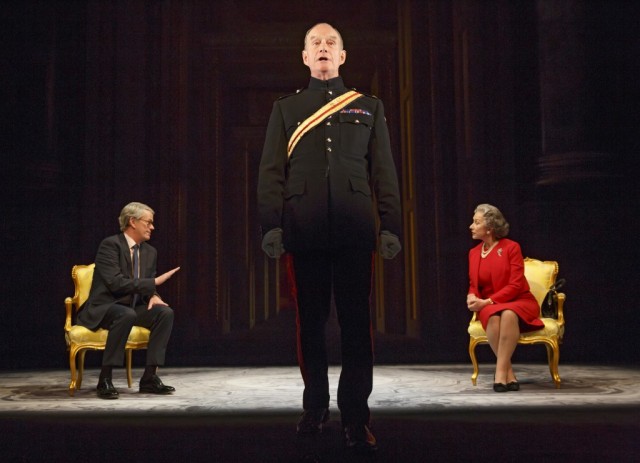
The queen’s equerry (Geoffrey Beevers) serves as a kind of Greek chorus unto himself in THE AUDIENCE (photo by Johan Persson)
Gerald Schoenfeld Theatre
236 West 45th St. between Broadway & Eighth Aves.
Tuesday – Sunday through June 28, $79-$157
theaudiencebroadway.com
In 2007, Helen Mirren won an Oscar for playing Queen Elizabeth II in Stephen Frears’s The Queen, which deals with England’s reaction to the death of Princess Diana. In 2013, Mirren won London’s prestigious Olivier Award for playing the queen onstage in The Audience, and she is certainly in line for a Tony nomination now that the production has moved to Broadway, running at the Gerald Schoenfeld Theatre through June 28. Both the film and the play were written by Peter Morgan, who specializes in fact-based dramas that imagine what goes on behind closed doors, including Damned United, The Last King of Scotland, and Frost/Nixon (which was a hit both onstage and onscreen). His works have been criticized for stretching credulity as he makes up dialogue and characters and creates scenes that are known to never have occurred, like the meeting of David Frost and President Richard Nixon that takes place at the end of Frost/Nixon. In The Queen, Morgan focused on Elizabeth and Prime Minister Tony Blair; in The Audience, he explores the queen’s relationship with eight of England’s elected political leaders (of the twelve PMs who have served during her reign, which began in 1952) through her weekly “audience” with them, a real tradition in which they come to Buckingham Palace and very briefly talk about what is happening in the country. The royal is supposed to just listen and nod in agreement, but Elizabeth often eschews what is expected and shares her own views, which shocks some and annoys others, although in the end she is always demure and graceful. One prime minister turns her into a therapist, while another develops an unusual friendship that finds him vacationing with her at Balmoral Castle. “You have a way of saying nothing and yet making yourself perfectly clear,” one of the prime ministers says to her. Of course, since the weekly audience is completely private, no one knows what was actually said, so giant leaps of faith are needed as the queen flirts with an aging Sir Winston Churchill (Dakin Matthews), discusses the Suez Canal with Sir Anthony Eden (Michael Elwyn), becomes a confidant to John Major (Dylan Baker), goes head-to-head with Margaret Thatcher (Judith Ivey), and develops a genuine rapport with Harold Wilson (Richard McCabe).
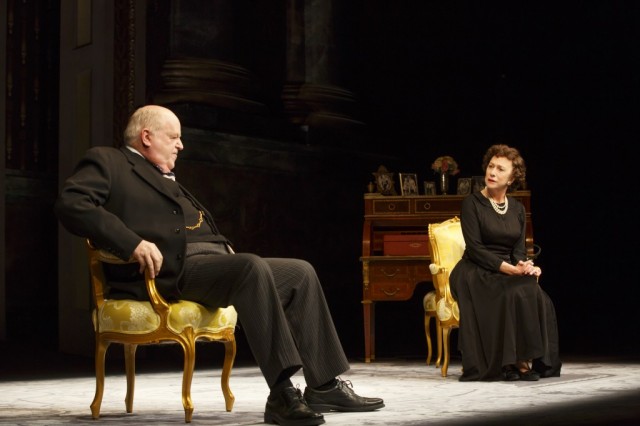
Sir Winston Churchill (Dakin Matthews) is uncomfortable meeting with Queen Elizabeth (Helen Mirren) in THE AUDIENCE (photo by Johan Persson)
Mirren is a marvel as the queen, magically changing clothes and hair onstage as the narrative jumps around through the years, splendidly capturing each era. (Hint: She is wearing multiple costumes at any one time, beautifully designed by Bob Crowley.) The story is too random, never establishing any legitimate conflict, and it seesaws between being too explanatory and not providing enough background information on British history, making references that will leave American audiences confused and, at times, just plain bored. It also gives a huge benefit of the doubt to the queen, as it’s a kind of love letter to British royalty that avoids controversy. McCabe excels as Wilson, a working-class slob who suddenly finds himself as the leader of a major world power, while Ivey is overly bombastic as Thatcher, inflating her into a caricature. The Audience features touching scenes of the young Elizabeth (alternately played by Sadie Sink and Elizabeth Teeter) appearing onstage as a memory, being taken care of by her dedicated nanny, Bobo McDonald (Tracy Sallows); the show would have benefited from more of those moments. Crowley’s set design is appropriately ornate and opulent; Geoffrey Beevers is playfully charming as the queen’s equerry, her dedicated right-hand man who explains in stately diction the provenance of the art and furniture, addressing theatergoers directly. Two-time Tony winner Stephen Daldry (Billy Elliot, An Inspector Calls) handles it all in a stylish, refined manner, doing what he can with a tale that is primarily built around two people sitting in chairs, talking about rather mundane things. The Audience is sure to find an audience, given its big-time star delivering a wonderful performance, but those who expect depth, surprise, or tension may leave their chairs not quite wholly in awe of the royal proceedings they have witnessed.
STRANGER THAN FICTION: THE MUSES OF ISAAC BASHEVIS SINGER
THE MUSES OF BASHEVIS SINGER (Asaf Galay & Shaul Betser, 2014)
IFC Center
323 Sixth Ave. at West Third St.
Tuesday, March 24, 8:00
212-924-7771
www.stfdocs.com
www.the-muses-of-bashevis-singer.com
 Who ever thought that little old Yiddish mensch Isaac Bashevis Singer was such a horndog? Asaf Galay and Shaul Betser begin The Muses of Bashevis Singer, their light and playful documentary, with the following quote from the Nobel Prize-winning author: “In my younger days I used to dream about a harem full of women. Lately I’m dreaming of a harem full of translators. If those translators could be women in addition, this would be paradise on earth.” Well, it seems that Singer, who was born in Poland in 1902, emigrated to the United States in 1935, and died in Florida in 1991 at the age of eighty-eight, found that paradise, as Galay and Betser meet with a series of women who were among many hand-picked by Singer, the man who nearly singlehandedly preserved Yiddish literature in the twentieth century, to serve as his translators, and not necessarily because of their language skills. “There were certain women who were more than just translators to him. It happened quite often,” says his Swedish publisher, Dorothea Bromberg, who also talks about Alma, Singer’s wife of more than fifty years. “He loved her, I’m sure, in his own way,” she adds. “She was very jealous of him, and she was completely right.” Galay and Betser meet with translators Eve Fridman, Evelyn Torton Beck, Dvorah Telushkin, Marie-Pierre Bay, Duba Leibell, and Dr. Bilha Rubenstein as well as Singer biographers Florence Noiville and Janet Hadda, his granddaughters Hazel Karr and Merav Chen-Zamir, Yentl the Yeshiva Boy playwright Leah Napolin, and his longtime secretary and proofreader, Doba Gerber, who share intimate, surprising tales about the author of such books as The Family Moskat, The Magician of Lublin, Shosha, and Enemies, a Love Story and such short stories as “Gimpel the Fool,” “A Friend of Kafka,” and “Zlateh the Goat.”
Who ever thought that little old Yiddish mensch Isaac Bashevis Singer was such a horndog? Asaf Galay and Shaul Betser begin The Muses of Bashevis Singer, their light and playful documentary, with the following quote from the Nobel Prize-winning author: “In my younger days I used to dream about a harem full of women. Lately I’m dreaming of a harem full of translators. If those translators could be women in addition, this would be paradise on earth.” Well, it seems that Singer, who was born in Poland in 1902, emigrated to the United States in 1935, and died in Florida in 1991 at the age of eighty-eight, found that paradise, as Galay and Betser meet with a series of women who were among many hand-picked by Singer, the man who nearly singlehandedly preserved Yiddish literature in the twentieth century, to serve as his translators, and not necessarily because of their language skills. “There were certain women who were more than just translators to him. It happened quite often,” says his Swedish publisher, Dorothea Bromberg, who also talks about Alma, Singer’s wife of more than fifty years. “He loved her, I’m sure, in his own way,” she adds. “She was very jealous of him, and she was completely right.” Galay and Betser meet with translators Eve Fridman, Evelyn Torton Beck, Dvorah Telushkin, Marie-Pierre Bay, Duba Leibell, and Dr. Bilha Rubenstein as well as Singer biographers Florence Noiville and Janet Hadda, his granddaughters Hazel Karr and Merav Chen-Zamir, Yentl the Yeshiva Boy playwright Leah Napolin, and his longtime secretary and proofreader, Doba Gerber, who share intimate, surprising tales about the author of such books as The Family Moskat, The Magician of Lublin, Shosha, and Enemies, a Love Story and such short stories as “Gimpel the Fool,” “A Friend of Kafka,” and “Zlateh the Goat.”
The seventy-two-minute film, lifted by a bouncy, airy soundtrack by Jonathan Bar-Giora, also includes footage of Singer making speeches, appearing on interview programs, going to a Jewish deli, walking on the Coney Island boardwalk, and writing with pen on paper and on a typewriter with Yiddish characters. But as the title implies, The Muses of Bashevis Singer doesn’t depict him as a callow cad but as a determined writer — and father and husband — who just loved women, loved being surrounded by women, using them as inspiration for his marvelous stories that mixed fiction with reality. “Isaac was a very frisky old man,” says Leibell, who worked with Singer in his later years after he moved to Florida with Alma. “That’s to put it very mildly.” The Muses of Bashevis Singer concludes the IFC Center’s winter Stranger than Fiction series on March 24 and will be followed by a Q&A with the director.
MACARON DAY NYC 2015
Who: Fifteen New York City food boutiques
What: Sixth annual Macaron Day NYC
Where: From Brooklyn to Bronxville, Port Authority to Rockefeller Center, Greenwich Village to Columbus Circle, and other locations
When: Friday, March 20, free while supplies last, 10:00 am – 5:00 pm
Why: Bouchon Bakery, Chantilly Patisserie, Eclair Bakery, Epicerie Boulud, François Payard Bakery, FP Patisserie, Macaron Café, Macaron Parlour, Mad-Mac “The Authentic French Macarons” at Bernardaud, Mille-Feuille Bakery, Spot Dessert Bar/Shoppe, Sugar and Plumm, Todd English Food Hall at the Plaza, Woops! and Bisous, Ciao. Macarons will be giving out free macarons on Friday, those classic French cookies with a delicate meringue shell and gourmet ganache inside, as a way to not only promote the macaron itself but to raise funds and awareness for hunger. Just tell them you’re there for Macaron Day NYC for a free sample, then buy some to take home; part of the proceeds will go to City Harvest.
